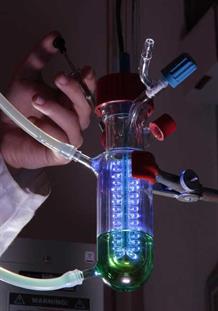Biotechnologies now have the scientific maturity to propose high-potential devices to respond to the challenges of low-carbon energies and energy-efficient industrial processes. They rely on bioenergetic control mechanisms, and more generally on the mechanisms of biological oxidation-reduction, as well as exploration of the diversity of metabolic pathways of microorganisms.
Low-cost catalysts for the production or utilization of hydrogen
 | The use of hydrogen as a “vector” of energy is based on
the control of its production in large quantities (by electrolysis of
water) and its utilization in fuel cells. However, the two processes
require expensive, rare catalysts like platinum. Researchers at the DSV (Life Sciences Division)
are finding inspiration from living organisms to develop new catalysts
based on abundant metals in nature, such as cobalt or iron. Their
favorite models are hydrogenases, enzymes which in some organisms have
chelated metal ions in their active sites to produce hydrogen, or to use
it as an energy source. Knowing the structure of the active site
provides essential design elements for innovation in catalysis. Some
bioinspired structures have already been incorporated into technological
devices.
Bioinspired photoproduction of hydrogen. In this device, hydrogen is produced from water by the action of an inorganic photocatalyst, inspired by the functioning of hydrogenases during photosynthesis. (CEA-IRTSV, Grenoble). ©P.
Avavian/CEA |
Third generation biofuels
The use of photosynthetic microorganisms such as microalgae (Chlamydomonas, diatoms, etc.) or cyanobacteria allows considering the production of third generation biofuels that will not mobilize agricultural land, as do first and second generation biofuels. Light, water and CO2 are almost sufficient to culture them. The DSV also studies these microorganisms in order to evaluate and reinforce their potential to synthesize lipids (for biodiesel or biokerosene), sugars (for bioethanol) and hydrogen, with the goal of achieving an elevated productivity in bioreactors. To accomplish this, teams at the DSV are trying to understand the fundamental mechanisms of photosynthesis, metabolic regulation, and stress resistance of these microorganisms. These approaches are the subject of partnerships with industry (including Fermentalg, Microphyt, and Total Énergies nouvelles). The use of microalgae would also bring other benefits by absorbing a part of industrial wastes in CO2 and coupling this to the recycling of wastewater.
Towards a clean industry, using biocatalysts for green chemistry
Industry often uses resources such as high temperatures or toxic solvents to accelerate chemical reactions, such as in the synthesis of innocuous products. Living organisms offer alternative solutions since the chemical reactions are often performed at room temperature and in neutral environments like water. This is accomplished through unparalleled catalysts at their disposal: enzymes, i.e. proteins that accelerate chemical reactions and ensure selectivity. Genomic analysis of biodiversity conducted at the DSV (see box) contributes to the inventory of these enzymes. Their functions are then tested by high-throughput screening in vitro.
| Another method resulting in economical industrial
energetic processes is to realize them directly by microorganisms,
usually bacteria. Synthetic biology techniques can be used for this,
which allow introducing a new metabolism either by genetic engineering
or by selective pressure. Containment is required for those organisms
whose functions have been modified. This can especially be guaranteed by
an original approach that uses genetic dependence on an essential
element that does not exist in natural environments, which must
therefore be introduced to the cell culture media to keep the
microorganism alive. | |